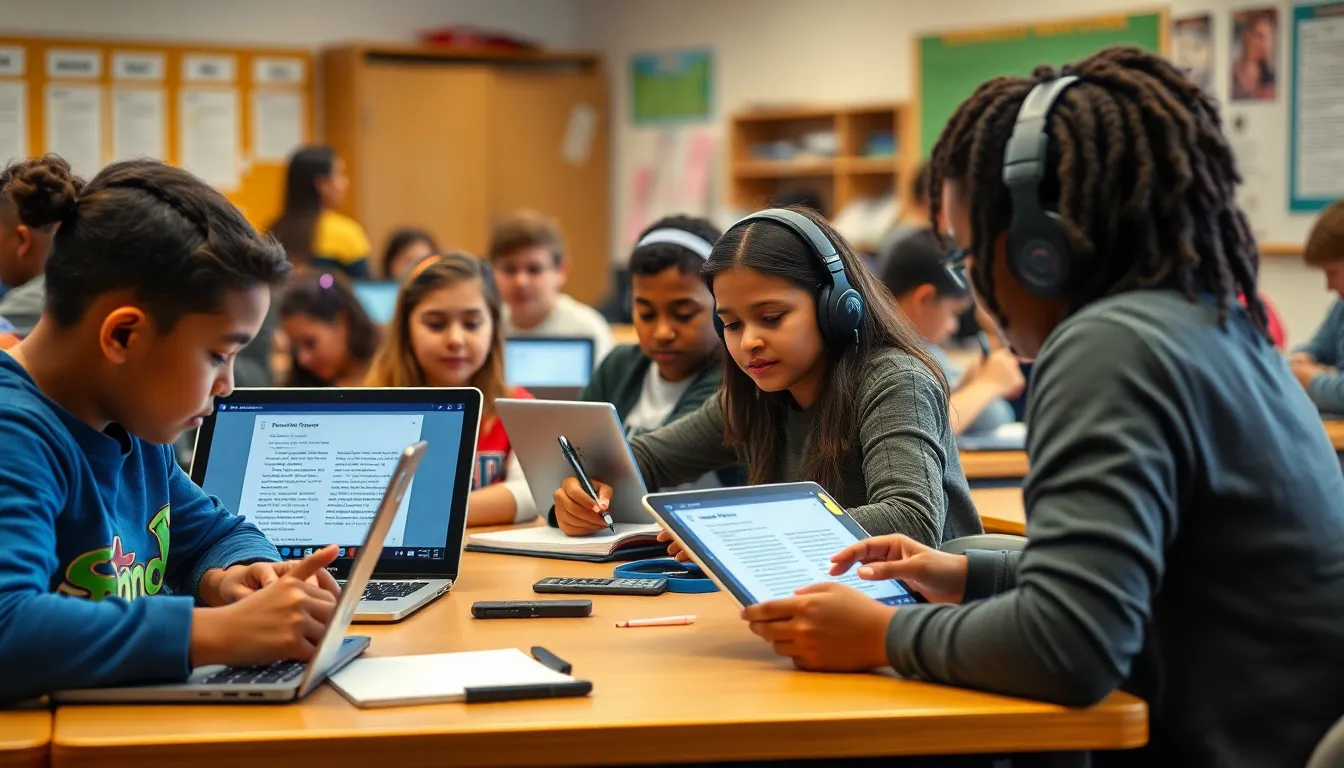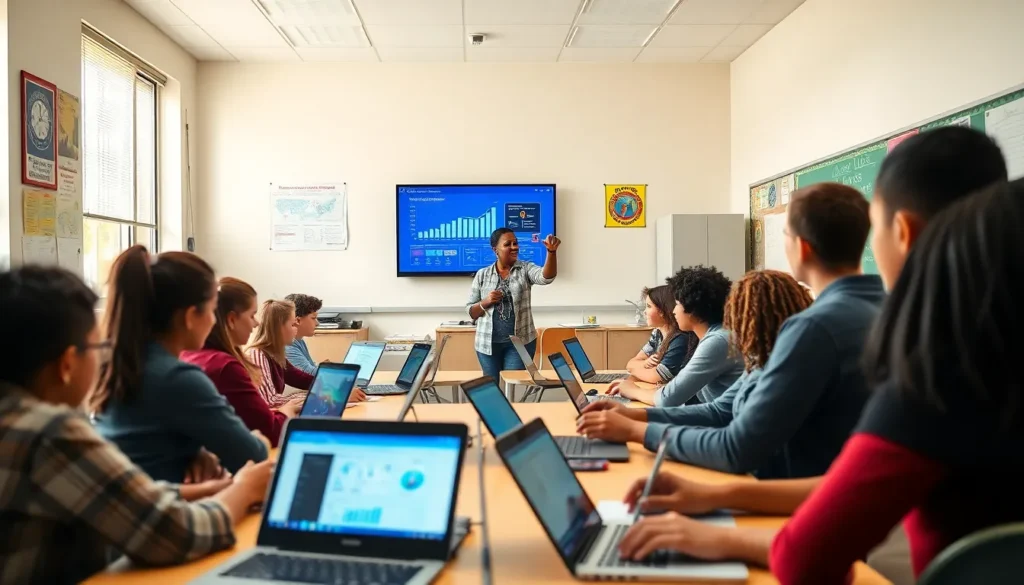In today’s digital age, inclusive educational technology isn’t just a buzzword—it’s a game changer. Imagine a classroom where every student, regardless of their abilities, can engage with learning materials that cater to their unique needs. Sounds like a dream, right? Well, it’s becoming a reality, and it’s time to jump on this tech train before it leaves the station!
Table of Contents
ToggleOverview of Inclusive Educational Technology
Inclusive educational technology encompasses tools and resources designed to support diverse learners. These technologies focus on meeting the individual needs of students, enabling them to engage meaningfully with the curriculum. Various platforms provide different features, allowing for personalized education experiences.
Assistive technologies, such as screen readers and speech-to-text software, empower students with disabilities to access learning materials. Learning management systems offer adjustable content, fostering a flexible learning environment. Tools like audiobooks and digital note-taking applications enhance comprehension for students with varied learning preferences.
Collaboration platforms facilitate peer interaction. Examples include forums and discussion boards, which promote communication among students. These platforms help students develop essential social skills while working together on assignments.
Data indicates that inclusive technologies improve academic performance. Studies show that students using such tools display higher engagement rates and increased motivation. Tailored educational experiences positively impact learning outcomes, enabling all students to thrive.
Professional development for educators reinforces the effective use of inclusive technology. Training programs highlight best practices and equip teachers with tools to create an inclusive classroom. School administrators play a vital role in supporting this initiative, ensuring access to necessary resources.
Implementing inclusive educational technology creates an equitable learning environment. By prioritizing accessibility and engagement, institutions can foster a culture of inclusivity. Success relies on ongoing collaboration among educators, administrators, and technology providers, ensuring that all students benefit from these advancements.
Importance of Inclusivity in Education

Inclusivity in education fosters a learning environment where all students can thrive. Embracing diverse abilities ensures that every learner engages with tailored resources.
Benefits for Diverse Learners
Assistive technology significantly enhances educational access for diverse learners. Screen readers and speech-to-text solutions empower students with disabilities by facilitating their participation in classroom activities. Audiobooks cater to different learning preferences, improving comprehension for auditory learners. Collaboration tools create opportunities for peer interaction, promoting essential social skills. Engagement levels rise as students encounter personalized learning experiences that meet individual needs.
Impact on Learning Outcomes
Improving academic performance stems from including diverse educational technologies. Data shows that students using inclusive tools exhibit higher engagement rates compared to their peers. Increased motivation also leads to improved retention of information, reinforcing learning experiences. Specific studies indicate that students with disabilities often outperform expectations when provided with the right technological support. Teachers equipped with this technology notice better learning outcomes across their classrooms, further promoting an equitable educational landscape.
Key Features of Inclusive Educational Technology
Inclusive educational technology incorporates essential features that enhance learning for all students. These features primarily focus on accessibility tools and customizable learning environments to cater to a broad spectrum of needs.
Accessibility Tools and Resources
Accessibility tools play a critical role in creating an inclusive educational landscape. Screen readers allow students with visual impairments to engage with digital content efficiently. Alternative input devices, such as adaptive keyboards and switches, facilitate interaction for individuals with physical disabilities. Captioning on videos ensures that students with hearing impairments can fully comprehend audio materials. Additionally, resources like audiobooks and text-to-speech applications support diverse learning preferences, enhancing understanding for various learners. Research indicates that students using these assistive technologies experience higher engagement rates and improved academic outcomes.
Customizable Learning Environments
Customizable learning environments empower educators to tailor educational experiences to individual student needs. Learning management systems offer options for personalizing course material, allowing adjustments based on students’ learning styles and preferences. Flexible content delivery formats, such as interactive modules and gamified lessons, encourage engagement among all learners. Teachers can modify assessments to accommodate different abilities, promoting fairness in evaluations. Peer collaboration tools further enhance social interactions, enabling students to learn from one another in a supportive setting. Studies show that such tailored approaches lead to greater motivation and academic success for diverse learners.
Challenges in Implementing Inclusive Educational Technology
Inclusive educational technology faces several challenges that can hinder its effective integration into classrooms. These obstacles range from technical issues to a lack of teacher training and support.
Technical Barriers
Technical barriers often impede the adoption of inclusive educational technology. Limited internet access affects some students, restricting their ability to utilize online resources. Compatibility issues between various devices and assistive technologies can make it difficult for students to engage fully with content. Additionally, outdated hardware and software may lack features necessary for inclusivity. Data shows that schools with reliable technology infrastructure report higher engagement rates among students using inclusive tools. Addressing these technical barriers is crucial for fostering an equitable learning environment.
Teacher Training and Support
Teacher training and support represent another significant challenge in implementing inclusive educational technology. Many educators lack adequate training on how to effectively use these tools in the classroom. Limited professional development opportunities hinder teachers’ ability to apply best practices for inclusive education. As a result, some educators may feel unprepared to accommodate diverse learning needs effectively. Research indicates that when teachers receive targeted training, student engagement and academic performance improve. Ensuring robust support for educators enhances their capacity to create inclusive learning environments.
Future Trends in Inclusive Educational Technology
Emerging trends in inclusive educational technology signal a significant shift toward more personalized learning experiences. Artificial intelligence plays a pivotal role, enabling adaptive learning systems to tailor content based on each student’s unique strengths and weaknesses. These AI-driven platforms assess student needs and customize resources accordingly.
Accessibility continues to be a primary focus, with new developments in assistive tools that enhance engagement for students with disabilities. Improved speech recognition software and smart devices offer greater flexibility in how students interact with learning materials. Furthermore, innovations in virtual reality create immersive environments that allow all learners to experience educational content in dynamic ways.
Another trend involves the integration of collaboration tools that foster engagement between peers. These platforms allow students to collaborate on projects, share insights, and elevate social interactions, thus enhancing overall learning outcomes. Enhanced communication features provide real-time feedback, ensuring that students and educators can connect effectively.
Research indicates that incorporating gamification into educational technology can boost motivation among diverse learners. Game-based learning not only captivates attention but also encourages participation from students who might otherwise struggle with traditional educational formats. Engaging designs and interactive elements keep students interested and committed to their learning journeys.
Finally, professional development remains critical in advancing inclusive educational technology. Ongoing training equips educators with necessary skills to implement these tools effectively. Despite a growing array of resources, many teachers still require targeted support to maximize the benefits of inclusive technology in their classrooms. Data reveals that schools investing in comprehensive teacher training experience heightened student engagement and improved academic performance, showcasing the importance of fostering an inclusive educational environment.
The integration of inclusive educational technology is essential for fostering an equitable learning environment. By prioritizing accessibility and personalization, educators can empower all students to thrive. Embracing assistive tools and adaptive learning systems not only enhances engagement but also promotes academic success across diverse learning needs.
Ongoing professional development for teachers is crucial to maximize the benefits of these technologies. As schools continue to evolve, collaboration among educators, administrators, and technology providers will play a vital role in overcoming challenges and ensuring that every student has the opportunity to succeed. The future of education lies in inclusivity, and the right technology can make all the difference.









